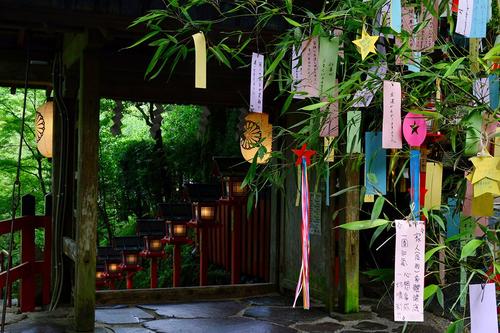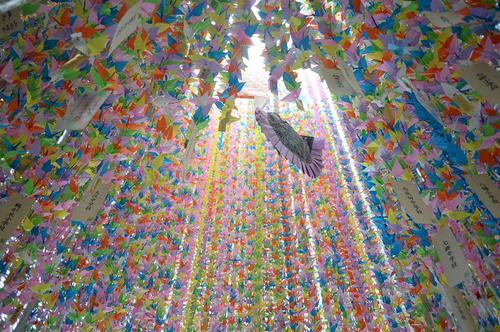Tanabata, held on July 7th, is a wonderful event where people of all ages, from children to adults, write their wishes on strips of paper. However, I think surprisingly few people know the meaning and origin of Tanabata.
In this article, we will explain in detail the three legends that are said to be the origins of Tanabata, as well as the meaning behind the strips of paper and decorations.
Tanabata is one of the five seasonal festivals

Tanabata is an annual event held on the night of July 7th to celebrate the stars. It is also one of the five seasonal festivals established during the Edo period.
The five seasonal festivals that were established as official events and holidays at the time were abolished as a system when the calendar was changed to the Gregorian calendar in 1873 (Meiji 6). However, the following five seasonal festivals, centered around Tanabata, have been passed down to the present day as seasonal events, albeit in a modified form.
- January 7th: Jinjitsu Festival
- March 3rd: Joshi (Jōshi/Jōmi) Festival
- May 5th: Boys' Day
- July 7th: Tanabata Festival
- September 9th: Choyo Festival
Three customs related to the meaning and origin of Tanabata

Japan's Tanabata is a mixed culture that combines legends and customs from both Japan and China. Among its many origins, the following three are well-known.
Tanabata Shelving Unit
Tanabata is an event that was held in ancient Japan to pray to the water god for a good harvest in the fall. In the past, kimonos woven by women called Tanabata no Tsume were offered to the god. The looms used to make kimonos were called "Tanabata."
Over time, Tanabata came to be held on July 7th as preparation for the Obon festival, and it is said that the name was later used to refer to Tanabata, one of the five seasonal festivals that falls on the same day.
The Legend of Orihime and Hikoboshi
The story of Orihime and Hikoboshi, which is well-known in Japan, has its roots in a star legend that was introduced to China. The general story goes that the Emperor of Heaven, angry at Orihime and Hikoboshi for not working at all after getting married, separated them by the Milky Way. The Emperor then allowed the two to cross the Milky Way once a year on July 7th, on the condition that they work hard.
Kikoden (Prayer for the dead)
Qiqiaoden is a Chinese custom that was introduced to Japan during the Nara period. The custom, which began as a prayer for improvement in sewing skills, naturally spread to the Japanese Imperial Court and evolved into a festival where women make offerings and pray on the night of Tanabata. It is said that Qiqiaoden, which was introduced to Japan along with the legend of Orihime and Hikoboshi, also took on the meaning of praying for a good relationship between men and women.
Tanabata decorations and paper strips also have meaning

Tanabata decorations also have various meanings and origins.
Five-colored strips of paper
The five-colored strips of paper that are displayed on Tanabata originate from the Chinese theory of Yin and Yang and the Five Elements. According to this theory, the world is made up of Yin and Yang, and the colors used on the strips have the following meanings:
- Blue and green strips: "trees" representing nature
- Red strips: "Fire" representing flames
- Yellow strips: "soil" symbolizing the earth
- White strip: "Gold" representing metal buried in the earth
- Black and purple strips: "Water" representing the nurturing of life
The colors of the tanzaku also represent the five virtues that were established by the Chinese philosopher Confucius.
- Blue and green strips of paper: "Jin" (benevolence)
- Red strips of paper: "Thank you" as a token of gratitude that embodies benevolence
- Yellow strips: "faith" in honesty and keeping promises
- White strip: "righteousness" that is not bound by selfish desires
- Black or purple strips of paper: Wisdom, which means working hard at your studies and striving for improvement
streamers
These ornaments originate from the legend of Orihime and Hikoboshi. The threads used by Orihime are expressed using paper and cloth. It is said that streamers represent wishes for improvement in sewing and weaving skills. If you make a colorful streamer using the same five colors as the tanzaku mentioned above, it is also said to have the effect of warding off evil spirits.
Thousand Paper Cranes
Cranes are birds that symbolize longevity, as the proverb goes, "A crane lives for a thousand years, a turtle for ten thousand years." In the past, people's lifespans were very short, so it is believed that folding a thousand paper cranes was a way of praying for the longevity of the elderly. Also, because pairs of cranes are known to be very close, they are also a symbol of marital harmony.
Kamiko (paper garment)
Kamikoro is a kimono-shaped decoration made from washi paper or origami. The purpose of including kamikoro in Tanabata decorations is said to be the same as windsocks, with the hope that women will become better at weaving. When looms were in widespread use, they were a popular decoration, just like strips of paper. Kamikoro, which resembles a human figure, also symbolizes the hope that children will grow up healthy.
purse
A drawstring bag in the shape of a wallet is an ornament that symbolizes good fortune in terms of money. In addition to bringing in a lot of money, it is also used to pray for good savings. Tanabata drawstring bag decorations often use yellow, which brings good fortune in terms of money. Some people decorate with real wallets instead of origami drawstring bags.
summary
Tanabata, famous for the story of Orihime and Hikoboshi, is a cultural fusion of Japanese and Chinese customs and legends. Tanabata decorations and paper strips are filled with wishes for things like improvement in sewing skills, good fortune, and long life.
When preparing for Tanabata before July 7th, knowing these meanings and origins will help you decorate in a way that will make everyone's wishes come true.
This article has been partially re-edited by KARUTA from an article originally published on "Nihongo Biyori."
Any unauthorized reproduction or use of the contents, text, images, illustrations, etc. of this website is strictly prohibited.
